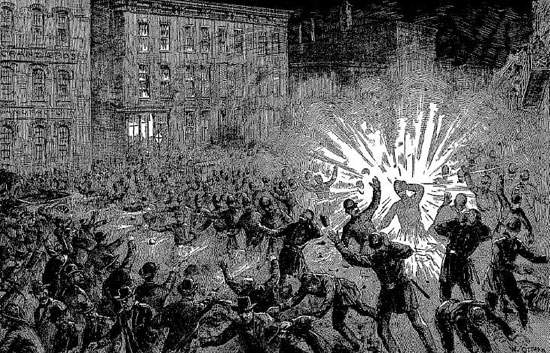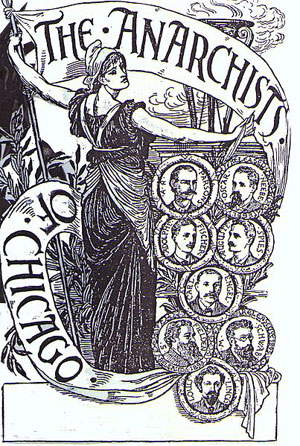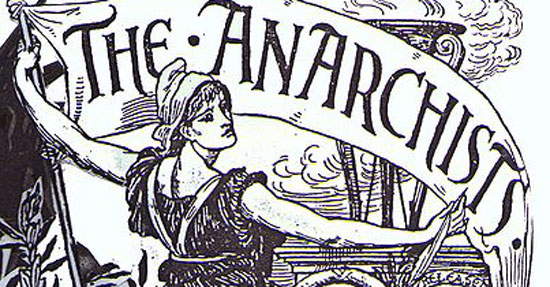To the origins of May Day. The Chicago martyrs (and Walter Crane's engraving celebrating them).
There will come a time when silence will be louder than the voices that today throttle
(August Spies)
Chicago, United States of America, May 1, 1886. Labor unions organize a strike to demand better working conditions from the bosses. In particular, they demand measures to adopt the eight-hour workday. At that time, workers worked an average of ten hours a day, including Saturdays, on normal workdays: when increases in production were needed, shifts came to occupy virtually the entire worker’s day. Of course, it goes without saying that, at that time, the concepts of “company benefits” and “overtime” were completely unknown.
On the streets of Chicago, thousands of workers gathered on May 1, 1886. Sources differ as to the exact number: some speak of twenty thousand in attendance, some estimate forty thousand, and some as high as fifty thousand. The most credible estimates are around thirty thousand people. Still high numbers, showing very active participation and a determined will to improve the workers’ situation. Indeed, the strike is successful, and the unions decide to follow up the protests in the following days as well. Two days later, on May 3, a rally is held in front of the gates of the McCormick Harvesting Machine Company, an agricultural machinery factory: the workers have long taken action against the company, which will not give in to the demands of its workers. During a protest opposing workers gathered in strike action on one side and scabs on the other, police fire on the protesters, resulting in the death of four people. The already tense atmosphere obviously does not benefit: the workers therefore decide to continue the protest, with a demonstration called for the following day.
The demonstration is held at 7:30 p.m. on May 4, in Haymarket Square, a short distance from McCormick’s headquarters. And the demonstration is nothing more than a rally held by some anarchists who have long fought for more humane working conditions: the crowd is harangued that evening by three of them. One is August Spies, a German immigrant who had had to leave his motherland following the disappearance of his father and the subsequent worsening of the family’s economic conditions: having arrived in the U.S., he became aware of the plight of workers, often immigrants like himself, and abandoned his conservative views to embrace first socialism and then libertarian ideals. In 1880 he founded a German-language newspaper, theArbeiter Zeitung (“Worker’s Daily”), which he took over as editor in 1884. Joining him in the square is Albert Parsons, a native of Alabama: always politically active on anti-slavery and anti-racist positions, he had been forced to leave the southern United States at a time when the climate of rampant racism was becoming dangerous for him and his family. Moving to Chicago, he continued his work as a journalist and trade unionist there. Finally, Samuel Fielden, from England, a carter by profession: he too embraces socialist ideals after his arrival in the United States. And he too becomes one of the most vocal supporters of labor struggles.
The rally was held in pouring rain, so much so that Fielden had to interrupt his speech, when moreover Spies and Parsons had already left the event. The event has been held peacefully and is thus drawing to a close, but two events occur that precipitate the situation: a police charge on the demonstrators and a bomb blast. Again, sources differ on whether the police charged the protesters following the blast, or whether the police unloaded on the workers for no reason, and the bomb went off during the confusion. The fact remains that it will never be known who threw the device: many think it was merely a provocation. The bomb kills a policeman, Mathias Degan: this is enough to trigger a violent crackdown against the anarchists. Spies, Parsons and Fielden are immediately taken into custody. Along with them are arrested Adolph Fischer, George Engel, Michael Schwab, Louis Lingg and Oscar Neebe. All are of German descent. Fischer is a printer and owner of a German-language newspaper, Der Anarchist. Engel, the oldest of the group, has a toy store, and during the heated stages of the demonstration, he was not even present: witnesses say he was already at home. Schwab, a factory worker, trade unionist and contributor to Spies’Arbeiter Zeitung, had only been in Haymarket Square for a few moments. Lingg is the youngest (just twenty-two at the time of his arrest), but also the least peaceful. He knows how to handle explosives with skill, has matured anarchist ideals already at home, and emigrated to the U.S. to escape compulsory conscription. However, he too is not in Haymarket Square on May 4. He would be arrested ten days later. Neebe, born in New York to a German family, is a baker, and he too contributes to theArbeiter Zeitung. And he too leaves the demonstration before the riots.
 |
| The Haymarket Square bomb blast, from an illustration of the time |
The trial of the eight anarchists starts on June 21. But it is immediately clear how it would turn out: the intent is not so much to punish the anarchists for some crime they committed, but to suppress the protests, with the use of force. In fact, the evidence against the defendants is weak, practically insubstantial, and does nothing to uncover the perpetrator of the bomb throwing, which, as mentioned earlier, would never be found. Spies, Parsons and Fielden are charged with inciting the crowd to violence. Lingg, Engel, and Fischer are charged with participating in a meeting on the night of May 3, during which, according to the prosecution, the three allegedly conspired to kill members of the police. In contrast, the defense argues that all that was discussed at the May 3 meeting was how to defend themselves against possible law enforcement attacks. That would have served no purpose. Accusations of fomenting violence are also levelled at Neebe (the mere discovery of a gun in his home was enough evidence) and Schwab. In the meantime, many newspapers contribute to a climate of strong hostility against workers and anarchists: there are those who advocate the public lynching of anarchists, there are those who want to see them condemned to death, those who paint them as monsters and murderers. And this climate is benefited by the repression of the state, which closes down many anarchist newspapers, arrests innocent people indiscriminately, and even goes so far as to threaten witnesses with torture if they made statements in favor of the defendants. But there are also those who support the anarchists’ cause: the Haymarket Square events in fact achieve great resonance. One need only mention George Bernard Shaw, who sent a telegram to the Illinois Supreme Court writing, “If the state of Illinois is to lose eight of its citizens, it had better lose the eight members of the Supreme Court.”
However, after a summary trial without overwhelming evidence, with artfully fabricated testimony, the verdict came on August 20, 1886: seven of the eight defendants were sentenced to death, while Neebe was given 15 years in prison. In the months that followed, Fielden and Schwab wrote to the governor of Illinois to ask for a pardon, which was granted to them. The others refuse: for them to ask for a pardon would be like admitting a guilt they do not have. They therefore prefer to die innocent. Lingg kills himself in prison the night before his execution, ingesting a small device he made himself. Spies, Parsons, Fischer and Engel are hanged on November 11. Seven years later, the newly elected governor of Illinois, John Peter Altgeld, declares that there had been very serious errors during the trial, and decides to have Fielden, Schwab and Neebe released from prison. This courageous decision marks the end of his political career: he is harshly attacked (including by future President Theodore Roosevelt, among others, who states that Altgeld “pardons and encourages the most infamous murderers”), and is defeated in subsequent elections for both governor and mayor of Chicago. The defeats, in conjunction with his deteriorating health, decree Altgeld’s final departure from the political scene.
 |
| Walter Crane, The Anarchists of Chicago (1894). |
Today, the eight anarchists are known as the Chicago Martyrs. In order to remember their sacrifice, in 1889 the Second International decided to establish an international day on May 1 to celebrate workers and to continue to fight for what the Chicago martyrs had fought for: the eight-hour workday.
In art, one of the earliest contributions to remembering the martyrs came from Walter Crane, an English painter at first influenced by the Pre-Raphaelites and then among the leading exponents of the Arts and Crafts movement, which played a major role in shaping what is universally known as the Art Nouveau style. Crane, in 1894, published an engraving entitled The Anarchists of Chicago as a tribute to the innocents sacrificed for their ideas. The work first appeared in November of that year in the anarcho-communist Liberty newspaper, but it was immediately a huge success: it was reproduced in several copies that achieved wide circulation in anarchist and socialist circles. A circulation that continues to this day: just do a search on the Internet to realize how often Walter Crane’s engraving appears on anarchist-area websites.
The work contains many symbolic references. The protagonist is a female figure, classically dressed, wearing a Phrygian cap on her head: one can therefore identify her with the allegory of freedom. However, it could also be an allegory ofanarchy, because on the left we notice a black banner, an anarchist symbol, and also because at the time, in conservative newspaper illustrations, anarchy was often depicted as a woman, in opposition to the forces of law and order, seen as an example of virility and masculinity. Although the woman is a symbol of freedom, she does not have the wings that are a typical attribute of liberty: this is because Crane’s intent is to avoid over-idealizing the composition, since the sacrifice of the eight martyrs was a real fact. The woman holds a drape with the inscription The Anarchists of Chicago, and behind her we notice a blazing brazier (the torch is a symbol of anarchy) rising above an altar on which are affixed eight medallions with the portraits and names of the anarchists tried after the Haymarket Square events. Olive leaves, on the other hand, are symbols of victory.
We cannot help but notice how pregnant the engraving is with references to classicism: the goddess, dressed in the antique style and in a pose that almost echoes Renaissance altarpieces, the altar, the olive tree, the medallions with the portraits. And these references have a specific reason: just as the classical era was seen as the age oforder and harmony, similarly anarchy is seen by Crane as a way to bring order and harmony into the world, precisely.
In the following years, statues and monuments then arose to honor the memory of the eight martyrs. Today, we remember them for their tremendous sacrifice, for suffering an unjust trial, for being sentenced simply to punish their ideas, and because, through their words and deeds, they enabled us to live in a better world. Let us remember the eight martyrs of Chicago and thank them for the example they set for us and for the achievements we were also able to obtain because of their courage.
 |
| Walter Crane, The Anarchists of Chicago (1894) - detail |
Warning: the translation into English of the original Italian article was created using automatic tools. We undertake to review all articles, but we do not guarantee the total absence of inaccuracies in the translation due to the program. You can find the original by clicking on the ITA button. If you find any mistake,please contact us.




























